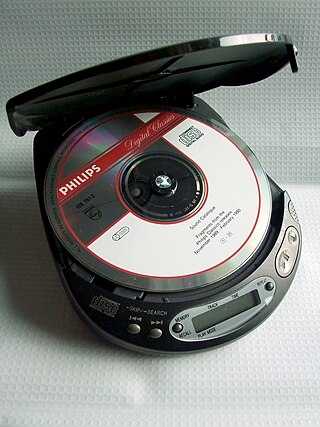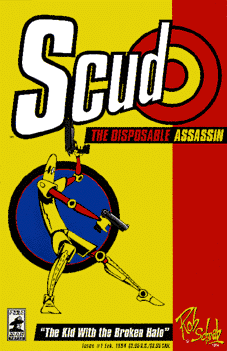
The compact disc (CD) is a digital optical disc data storage format that was codeveloped by Philips and Sony to store and play digital audio recordings. It uses the Compact Disc Digital Audio format which typically provides 74 minutes of audio on a disc. In later years, the compact disc was adapted for non-audio computer data storage purposes as CD-ROM and its derivatives. First released in Japan in October 1982, the CD was the second optical disc technology to be invented, after the much larger LaserDisc (LD). By 2007, 200 billion CDs had been sold worldwide.

An optical disc is a flat, usually disc-shaped object that stores information in the form of physical variations on its surface that can be read with the aid of a beam of light. Optical discs can be reflective, where the light source and detector are on the same side of the disc, or transmissive, where light shines through the disc to be detected on the other side.

The VHS is a standard for consumer-level analog video recording on tape cassettes, introduced in 1976 by the Victor Company of Japan (JVC). It was the dominant home video format throughout the tape media period in the late 1970s, 1980s, and 1990s.

Super Audio CD (SACD) is an optical disc format for audio storage introduced in 1999. It was developed jointly by Sony and Philips Electronics and intended to be the successor to the compact disc (CD) format.

A CD player is an electronic device that plays audio compact discs, which are a digital optical disc data storage format. CD players were first sold to consumers in 1982. CDs typically contain recordings of audio material such as music or audiobooks. CD players may be part of home stereo systems, car audio systems, personal computers, or portable CD players such as CD boomboxes. Most CD players produce an output signal via a headphone jack or RCA jacks. To use a CD player in a home stereo system, the user connects an RCA cable from the RCA jacks to a hi-fi and loudspeakers for listening to music. To listen to music using a CD player with a headphone output jack, the user plugs headphones or earphones into the headphone jack.

DVD-Audio is a digital format for delivering high-fidelity audio content on a DVD. DVD-Audio uses most of the storage on the disc for high-quality audio and is not intended to be a video delivery format.
A screener (SCR) is an advance or promotional copy of a film or television series sent to critics, awards voters, video stores, and other film industry professionals, including producers and distributors. It is similar to giving out a free advance copy of books before it is printed for mass distribution. Director John Boorman is credited with creating the first Oscar screeners to promote his film The Emerald Forest in 1985.
A self-destruct is a mechanism that can cause an object to destroy itself or render itself inoperable after a predefined set of circumstances has occurred.

Closure is the first video album by American industrial rock band Nine Inch Nails, released on November 25, 1997. The double VHS set consists of one tape of live concert and behind-the-scenes footage from their Self-Destruct and Further Down the Spiral tours and one tape of music videos.

Flexplay is a trademark for a discontinued DVD-compatible optical video disc format with a time-limited playback. They are often described as "self-destructing", although the disc merely turns black or dark red and does not physically disintegrate. The technology launched in August 2003 as a joint-venture with Disney's Buena Vista Home Entertainment under the name eZ-D. The Flexplay concept was invented by two professors, Yannis Bakos and Erik Brynjolfsson, who founded Flexplay Technologies in 1999. The technology was developed by Flexplay Technologies and General Electric.

Scud: The Disposable Assassin is a humorous, hyperkinetic science fiction comic by Rob Schrab about a world in which one can buy robot assassins out of vending machines, the most popular of which are intelligent robots that kill a specified target and then self-destruct.
Disc rot is the tendency of CD, DVD, or other optical discs to become unreadable because of chemical deterioration. The causes include oxidation of the reflective layer, reactions with contaminants, ultra-violet light damage, and de-bonding of the adhesive used to adhere the layers of the disc together.
Pirated movie release types are the different types of pirated movies and television series that are shared on the Internet. The quality and popularity of pirated movie release types vary widely, due to the different sources and methods used for acquiring the video content, the development and adoption of encoding formats, and differing preferences on the part of suppliers and end users as to quality and size-efficiency.
"Bodyswap" is the fourth episode of science fiction sitcom Red Dwarf Series III, and the sixteenth overall. It premiered on the British television channel BBC2 on 5 December 1989. Written by Rob Grant and Doug Naylor, and directed by Ed Bye. This was the first episode to be recorded without a live studio audience. The plot has Rimmer suggesting that the perfect way to help Lister get "healthy" is swapping bodies. The episode was re-mastered, along with the rest of the first three series, in 1998.

The DVD is a digital optical disc data storage format. It was invented and developed in 1995 and first released on November 1, 1996, in Japan. The medium can store any kind of digital data and has been widely used to store video programs, software and other computer files. DVDs offer significantly higher storage capacity than compact discs (CD) while having the same dimensions. A standard single-layer DVD can store up to 4.7 GB of data, a dual-layer DVD up to 8.5 GB. Variants can store up to a maximum of 17.08 GB.

Blu-ray is a digital optical disc data storage format designed to supersede the DVD format. It was invented and developed in 2005 and released worldwide on June 20, 2006, capable of storing several hours of high-definition video. The main application of Blu-ray is as a medium for video material such as feature films and for the physical distribution of video games for the PlayStation 3, PlayStation 4, PlayStation 5, Xbox One, and Xbox Series X. The name refers to the blue laser used to read the disc, which allows information to be stored at a greater density than is possible with the longer-wavelength red laser used for DVDs.

Before I Self Destruct is the fourth studio album by American rapper 50 Cent, released November 9, 2009, on Shady Records, Aftermath Entertainment, G-Unit Records, Interscope Records and Universal Music Group. The album is his final solo release with Shady, Aftermath and Interscope excluding his 2017 Greatest Hits album Best Of. An accompanying feature film of the same name coincided with its release, and is available within the albums packaging.
A digital copy is a commercially distributed computer file containing a media product such as a film or music album. The term contrasts this computer file with the physical copy with which the digital copy is usually offered as part of a bundle. It allows the disc's purchaser to acquire a single copy of the film on a digital device such as a personal computer, smartphone, tablet computer, or digital media player, and view it on those devices without requiring access to the physical media. "Digital copy" is also commonly referred to as "Digital HD".

M-DISC is a write-once optical disc technology introduced in 2009 by Millenniata, Inc. and available as DVD and Blu-ray discs.

Hardwired... to Self-Destruct is the tenth studio album by American heavy metal band Metallica, released as a double album on November 18, 2016, by the band's record label Blackened Recordings. It was Metallica's first studio album in eight years following Death Magnetic (2008), marking the longest gap between studio albums in the band's career, and its first studio album released through Blackened. The album was produced by Greg Fidelman, who engineered and mixed Death Magnetic.













